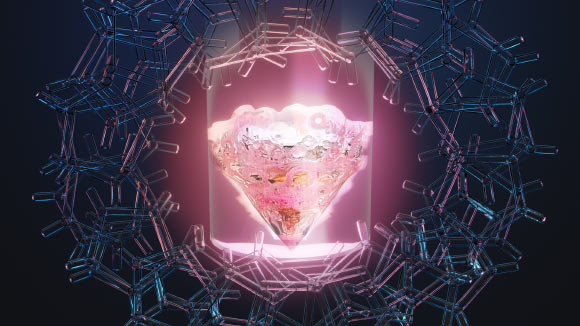Promethium is extremely rare: only about 0.5 kg occurs naturally in the Earth’s crust at any time.
Conceptual art shows the rare earth element promethium in a vial surrounded by an organic ligand. Image credits: Jacqueline DeMink / Thomas Dyke / ORNL.
Promethium, discovered in 1945 at Clinton Laboratories, is a lanthanide element with the symbol Pm and atomic number 61.
It is named after the mythological Titan who brought fire to people and whose name symbolizes human endeavor.
Some of its properties have remained elusive, despite the use of the rare earth element in medical research and long-life nuclear batteries.
“The whole idea was to explore this very rare element to gain new knowledge,” said Dr. Alex Ivanov, a researcher at Oak Ridge National Laboratory.
Dr. Ivanov and his colleagues prepared a chemical complex of promethium, allowing its characterization in solution for the first time.
Thus, they uncovered the secrets of this element in a series of painstaking experiments.
“Because it has no stable isotopes, promethium was the last lanthanide discovered and the most difficult to study,” said Dr. Ilja Popovs, also of Oak Ridge National Laboratory.
“There are thousands of publications on the chemistry of lanthanides without promethium. That was a glaring gap for all of science,” said Dr. Santa Jansone-Popova, also of Oak Ridge National Laboratory.
“Scientists have to assume most of its properties. Now we can actually measure some of them.”
The researchers bonded or chelated radioactive promethium with special organic molecules called diglycolamide ligands.
They then used X-ray spectroscopy to determine the properties of the complex, including the length of promethium’s chemical bond with neighboring atoms – a first for science and a long-standing missing piece in the periodic table of elements.
Unlike other rare earth elements, only minute amounts of synthetic promethium are available because it has no stable isotopes.
For the research, the scientists produced the isotope promethium-147, with a half-life of 2.62 years, in sufficient quantities and with a high enough purity to study its chemical properties.
Notably, they provided the first demonstration of a feature of lanthanide contraction in solution for the entire lanthanide series, including promethium, atomic number 61.
Lanthanide contraction is a phenomenon in which elements with atomic numbers between 57 and 71 are smaller than expected.
As the atomic numbers of these lanthanides increase, the radii of their ions decrease.
This contraction creates distinctive chemical and electronic properties because the same charge is confined to a shrinking space.
The authors got a clear promethium signal, which allowed them to better define the shape of the trend – across the entire series.
“From a scientific point of view, it’s really amazing. I was impressed when we had all the data,” said Dr. Ivanov.
“The contraction of this chemical bond accelerates along this atomic sequence, but after promethium it slows down significantly.”
“This is an important milestone in understanding the chemical bonding properties of these elements and their structural changes along the periodic table.”
“This achievement will, among other things, facilitate the difficult task of separating these valuable elements,” said Dr. Jansone-Popova.
“Our team has been working on separations for the entire range of lanthanides for a long time, but promethium was the final piece of the puzzle. It was quite challenging.”
“You can’t use all these lanthanides as a mixture in modern advanced technologies because you have to separate them first.”
“This is where the contraction becomes very important; it actually allows us to separate them, which is still quite a difficult task.”
“Anything we would call a modern technology marvel would contain these rare earth elements in some form,” said Dr. Popovs.
“We add the missing link.”
The team’s article appears today in the magazine Nature.
_____
D. M. Driscoll et al. Observation of a promethium complex in solution. Nature, published online May 22, 2024; doi: 10.1038/s41586-024-07267-6
